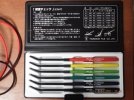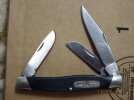- Joined
- Mar 28, 2020
- Messages
- 6,427
It is probably the stated 425M. Your approach towards sharpening them just needs alteration. Even their notoriously hard 440C will be easily cut by synthetic stones in good condition.
If you don't mind marring the blade surface, try using the chisel-like end corner of the file like a scribe to scratch the blade. Just because the file isn't biting isn't always a problem of hardness. Most people complain of the 425M blades not holding an edge well. It's not magic steel, and isn't even considered "good" by current standards. Stainless is just hard on files, especially martensitic hardened stainless. And that particular stone set sounds like there's something funky going on with it that would need refurbishing to work well.
I bought these Japanese files like in the photo. The blades do seem to hold an edge longer than usual. I also remember breaking the tip on the clip point blade and the sheepsfoot long ago and was surprised that they broke off.


